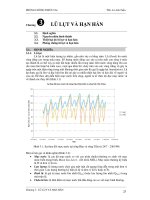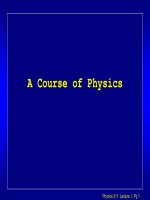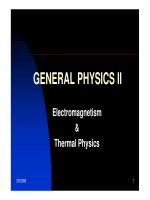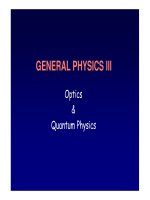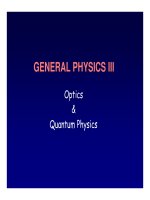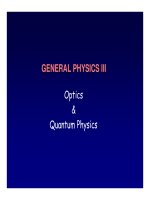- Trang chủ >>
- Khoa Học Tự Nhiên >>
- Vật lý
Tài liệu CHAPTER VII Static Electric Field docx
Bạn đang xem bản rút gọn của tài liệu. Xem và tải ngay bản đầy đủ của tài liệu tại đây (711.71 KB, 66 trang )
Physics 211: Lecture 1, Pg 1
A Course of Physics
A Course of Physics
Physics 211: Lecture 1, Pg 2
GENERAL PHYSICS II
GENERAL PHYSICS II
Electromagnetism
&
Thermal Physics
Physics 211: Lecture 1, Pg 3
CHAPTER VII
CHAPTER VII
Static Electric Field
Static Electric Field
§1. Electric charges. Coulomb’s law
§2. Electric field and electric field vector
§3. Electric flux and Gauss’s law
§4. Electric potential
Physics 211: Lecture 1, Pg 4
z
It is known that in nature there are four kinds of fundamental
forces which are caused by:
¾ gravitational interaction
¾ electromagnetic interaction (between static or moving
electric charges)
¾ strong interaction (that connects protons and neutrons in
nuclei)
¾ weak interaction (that drives the beta decay)
z
We consider now the electromagnetic interaction:
¾ static electric forces between charges
¾ magnetic field between currents (moving charges)
Physics 211: Lecture 1, Pg 5
§
§
1. Electric charges
1. Electric charges
–
–
Coulomb
Coulomb
’
’
s law
s law
1.1 Electric charges:
z
Some history of the concept “electric charge”:
¾ In 600 B.C. (Before Christ) ancient Greeks discovered that
when they rubbed amber with wool, the amber could then
attract light objects (feather,…). Today we say that the amber
acquired an electric charge, or has become charged.
(the Greek word elektron means amber)
¾ Many experiments has shown that there are exactly two
kinds of electric charge:
» The charge of the same kind with charge on the plastic rod
rubbed with fur it is called negative charge
» The charge of the same kind with charge on the glass rod
rubbed with silk it is called positive charge
(then the fur has positive, and the silk has negative charge)
The names negative and positive charges were suggested
by B. Franklin (1706 – 1790).
Physics 211: Lecture 1, Pg 6
¾ With the modern knowledge about the structure of matter
we know that electric charges come from elementary
particles: negatively charged electron and positively charged
proton. In nuclei there are also neutron with no charge.
z
Interaction between charges: two positive charges or two
negative charges repel each other. A positive charge and a
negative charge attract each other. This interaction is called the
static electric interaction.
z
Two important principles for charges:
¾ The principle of conservation of charge: “The algebraic sum
of all the electric charges in any closed systeme is constant”
¾ “The magnitude of charge of the electron or proton is a
natural unit of charge”. It is also called the element charge,
that is the smallest charge which cann’t devided into smaller
charges.
Physics 211: Lecture 1, Pg 7
2.2 Coulomb’s law:
z
Interaction forces of charges are studied by French
physicsist Charles Augustin de Coulomb (1736 – 1806).
The Coulomb’s law was established in 1785.
Physics 211: Lecture 1, Pg 8
Physics 211: Lecture 1, Pg 9
z
Comparison of electric and gravitational forces:
Physics 211: Lecture 1, Pg 10
z
Superposition of electric forces:
F = F
1
+ F
2
Physics 211: Lecture 1, Pg 11
z
Example 1:
Physics 211: Lecture 1, Pg 12
z
Example 2:
Physics 211: Lecture 1, Pg 13
Physics 211: Lecture 1, Pg 14
Physics 211: Lecture 1, Pg 15
§
§
2. Electric field and electric field vector:
2. Electric field and electric field vector:
2.1 The concept of electric field:
z
Why two electric charges A and B in empty space can exert force
each on other?
Modern physics gives the answer:
The charged body A, as a result of the charge that it carries,
somehow modifies the properties of space around it. Around the
body A then there exists a form of matter – the electric field. The
field exerts force on the charged body B.
A
B
Physics 211: Lecture 1, Pg 16
z
More on the concept of FIELD:
¾ Besides the electric field we have known the gravitational
field
¾ Generally, a field is something that can be defined anywhere
in space, it can be represented by a function of 3-D spatial
position f (x, y, z) :
» Temperature field: for each location in space the
temperature has a definite value → T = T (x, y, z).
Temperature is scalar quantity → the temperature field is
a scalar field.
» Force fields, as electric field or gravitational field are
vector fields.
At each point in space,
we define a vector
E = E (x, y, z)
(x,y,z)
E=E(x,y,z)
Physics 211: Lecture 1, Pg 17
2.2 Definition of electric field vector:
Physics 211: Lecture 1, Pg 18
z
Superposition of electric field:
How can determine the electric field due to a system of many
charges?
We know the principle of superposition of forces: the net force
which exerts on body is the vector sum of all the component
forces
the electric field vector for a system of charges is equal to
the vector sum of all the electric field vectors due to each charge
E =
Σ
i
E
i
z
Units of electric field: From the definition, the units of E is N / C .
Physics 211: Lecture 1, Pg 19
Physics 211: Lecture 1, Pg 20
Example 1:
Physics 211: Lecture 1, Pg 21
Physics 211: Lecture 1, Pg 22
The magnitude of the force F which exerts on Q:
F = | Q | E = 135 N
Physics 211: Lecture 1, Pg 23
Example 2:
Example 2:
It is an example of calculation of electric field due to a continuous
distribution of charges
Find the electric field due to a line of total charge q and length l
at a distance l from center of the line (the charge density is uniform):
(a) along the line;
(b) perpendicular to the line from center.
Physics 211: Lecture 1, Pg 24
(a) This field is due to a continuous distribution of charge, so we use
the formula
The field is along the x-direction, so we can ignore the vector signs.
The charge density is uniform
Substituding dq and r = l – x in E, we have
Let u = l – x, then
Physics 211: Lecture 1, Pg 25
(b) In this case, the x-components
will cancel out, leaving only
the y-components
dq is as before, and
Express x in terms of θ and integrate
